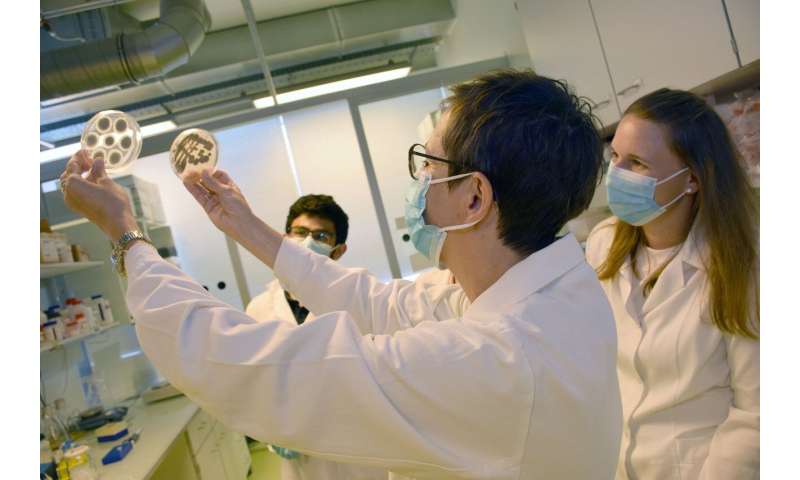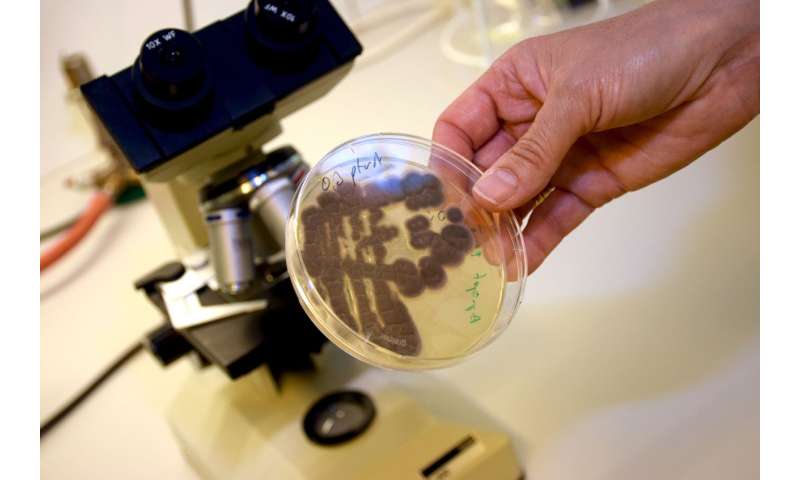A new way of combating fungal infections
by Science X staff
In agriculture, fungicides are used to combat fungal infections, and in medicine, antimycotics—both of which have their drawbacks. The microbiologist Florentine Marx-Ladurner is working on a new, more natural active antifungal compound based on proteins that originate from molds.
Fungal infections can have serious consequences. In agriculture, fungi can infest any type of crop and require applications of fungicides that are expensive and potentially hazardous for the environment. In human beings, fungal infestation of the skin, mucous membranes and nails causes problems and may even present a fatal danger for patients with a weakened immune system—following organ transplants, for example. Existing drugs (antimycotics) that fight fungal infestations often have severe side effects and contribute to the development of resistance.
Florentine Marx-Ladurner and her research group at the Medical University of Innsbruck are conducting basic research as part of the international project "The gamma-core motif of antifungal proteins from Ascomycetes" (2017-2022) with funding from the Austrian Science Fund FWF. Her research could lead to significantly cheaper and better tolerated anti-fungal agents—both in agriculture and medicine. The researchers set their hopes on naturally produced proteins that can also be found in fungal organisms themselves, for example in the mold Penicillium chrysogenum—the species that also provided the famous first antibiotic.
An inexhaustible source of active substances
"It comes as no surprise that fungi also produce components with an antifungal effect. They are known to be an almost inexhaustible source of substances that we can put to good use. In addition to penicillin, for example, certain cholesterol-inhibiting substances also originate from fungi. For a long time, citric acid was another important product obtained from molds," Marx-Ladurner explains. In the fungus itself, the antifungal proteins play a role in the formation of fungal spores which serve to spread the organism—for Penicillium, Marx-Ladurner and her colleagues have already been able to establish proof of this fact. For another mold that is the subject of investigation in the project—Neosartorya fischeri—they are still working on producing such functional evidence.

Complex structural elements in proteins
In order to explore the antifungal effect, the researchers focused on certain structural elements of the proteins. A well-known general characteristic of proteins is their complex 3-D structure, which plays a major role in determining their function. Some of these structures, which are the result of the way amino acids are arranged, are folded in such a way that they resemble the Greek letter γ, or gamma, which is known in research as a γ-core motif. The antifungal proteins from the molds also present structural elements of this type.
Marx-Ladurner and her team have demonstrated that these γ-core motifs from the antifungal proteins already have the desired effect on their own. "With the help of research partners we have produced various peptides for this purpose, i.e. small organic compounds consisting only of the protein sections of the γ-core motif," Marx-Ladurner explains. In this way they have not only proved their effectiveness, but have also shown how to enhance the antifungal effect even more. "The experiments clearly show that the desired effect does not depend on the arrangement of the amino acids but on other factors: by replacing distinct amino acids with others that renders the short motif more water-soluble and give it a positive charge, the antifungal activity can be drastically reinforced," says Marx-Ladurner.
Criteria for the selection of active substances
Before these protein or peptide variants actually make it into practice, the researchers need to test many more of their properties. Aspects under investigation include their thermal stability, their interaction with other substances or their behavior during metabolic degradation processes, but also their effects on the body cells of higher organisms, i.e. whether they damage cell membranes or induce antibody reactions. "There are many criteria that limit the selection of an active substance," Marx-Ladurner notes. "But we have been able to demonstrate both an increase in antifungal efficacy together with high stability and thermal tolerance for at least one of the proteins with a modified γ-core motif."
In the future, successful candidates for active substances could be used as plant protection products or as skin products with an antimycotic effect. But this will not be end of the journey. Using the fungicidal potency of proteins in the human body in the shape of drugs would require further extensive research. Further options also exist in agriculture, as Marx-Ladurner explains: "It might be possible to modify the genetic material of cultivated plants so that they themselves produce the antifungal protein—and, thus, their own plant protection product. As things stand, there is no answer to the question of whether this will actually be feasible."
More information: Liliána Tóth et al. The potential use of the Penicillium chrysogenum antifungal protein PAF, the designed variant PAF opt and its γ‐core peptide Pγ opt in plant protection, Microbial Biotechnology (2020). DOI: 10.1111/1751-7915.13559
Jeanett Holzknecht et al. The Penicillium chrysogenum Q176 Antimicrobial Protein PAFC Effectively Inhibits the Growth of the Opportunistic Human Pathogen Candida albicans, Journal of Fungi (2020). DOI: 10.3390/jof6030141
Liliána Tóth et al. Biofungicidal Potential of Neosartorya (Aspergillus) Fischeri Antifungal Protein NFAP and Novel Synthetic γ-Core Peptides, Frontiers in Microbiology (2020). DOI: 10.3389/fmicb.2020.00820
Christoph Sonderegger et al. The Evolutionary Conserved γ-Core Motif Influences the Anti-Candida Activity of the Penicillium chrysogenum Antifungal Protein PAF, Frontiers in Microbiology (2018). DOI: 10.3389/fmicb.2018.01655
Provided by Austrian Science Fund (FWF)